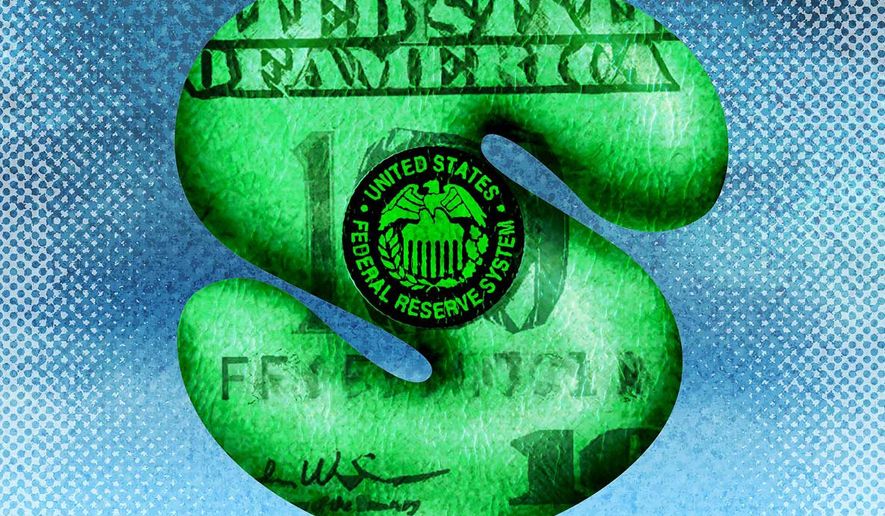OPINION:
The story goes Joe Kennedy knew it was time to short stocks just before the 1929 crash, when the shoeshine boys were dispensing investment tips. The market frenzy was complete — everyone had bought in, and no more fools were left to add the new oxygen necessary to keep a bubble going.
Now with inflation, the Fed has convinced itself and financial markets the recent surge in prices is temporary. That forecast is politically expedient — it’s in line with President Biden’s budget.
The Fed predicts price increases will fall to 2.1 percent next year and stays there for the foreseeable future, and the pace implied by inflation-indexed bonds is not much higher. But the business leaders that actually pay wages, buy computer chips and basic commodities, confront electric bills and purchase equipment — see prices going up a lot faster.
The disconnect is so stark because the bond market takes its cues from the Fed chairman and senior policymakers, who in turn are influenced by staff macroeconomists. Those sorcerers have a penchant for reducing a $21 trillion economy with supply tentacles reaching to the edges of the globe to just a few equations. But beneath those behavioral rules — like the fabled Phillip’s Curve — are a myriad of real-world conditions that are changing rapidly while econometric models are estimated with historical data.
Pandemics, like wars, create barriers to accustomed patterns of spending — restaurant closures this time and food rationing in World War II. When crises pass, folks go back to old ways but not completely. Hybrid offices will permanently cut purchases of food at city eateries and elevate demand for home office space, equipment and collaborative software.
Many restaurants and jobs for working class and minority Americans are lost for good, the demand for materials like copper, chips and software to equip and enable a more distributed professional workforce won’t go back to 2019 levels. Shortages and booming prices and wages for skilled workers in those industries are here to stay unless the Fed exerts considerable monetary discipline.
Over the two decades, new home construction has been depressed, but now millennials on the upper leg of the K-shaped job market, commuting less, are ploughing into suburban home ownership. Builders are responding but are butting up against shortages of building lots, lumber and other materials and skilled tradesmen from years of underinvestment in sawmills, factories and vocational education that the Fed can’t fix as its inflation forecasts require.
As the Commerce Department only includes the implied rents homeowners pay themselves with a lag — and those account for 24 percent of the Consumer Price Index — we know two things. Home prices will continue to rise at a quick pace, and their impact on measures of consumer inflation will continue for years.
Over the last two decades, manufactures and consumer service providers — read call centers at Amazon and credit card companies — have stretched supply chains into China and elsewhere in Asia in search of the lowest wages.
Pandemic shutdowns, shortages of imported components showed the vulnerability of such strategies and diversification and reshoring away from the lowest price source are the buzz words. And the lowest price source isn’t what it used to be — China’s working age population is shrinking. All that points to prices rising a lot more than over the past decade.
American workers can be retrained.
Levi Strauss is retooling brick and mortar retail workers for skilled digital positions with a two-month intensive bootcamp in coding and data analytics. Instead of piggy backing on such efforts, Mr. Biden wants to offer two years of free community college.
Levi’s trainees get paid and pay their rent. At community colleges, displaced restaurant workers will be subjected to woke indoctrination, questionably useful training delivered by proselytizing professors and borrow for living expenses.
The Fed is enormously pressured to validate that folly along with a plethora of social programs demanded by the hard left ideologies staffing the Biden administration. A good deal of the president’s $3 trillion in proposed non-infrastructure social spending would be financed by the Fed buying bonds to suppress interest rates — his budget projections don’t work without that.
During the pandemic the Fed printed over $3 trillion to buy bonds, and its balance sheet now exceeds 35 percent of the national debt held by the public. At its June policymaking meeting it said it will keep buying billions in Treasuries and mortgage-backed securities.
All that money chasing goods in short supply will ultimately leave Messrs. Biden and Powell, as Ricky Ricardo would say, with some “splaining to do.”
• Peter Morici, @pmorici1, is an economist and emeritus business professor at the University of Maryland, and a national columnist.




Please read our comment policy before commenting.